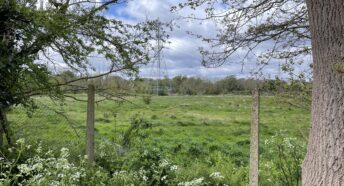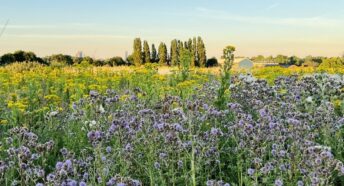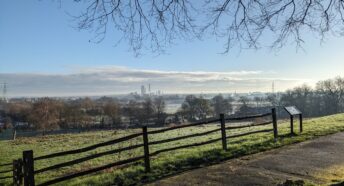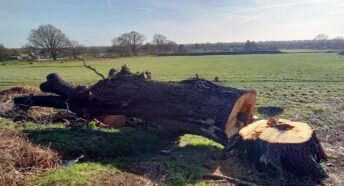London's green spaces under threat
We are emerging from a pandemic which focussed our minds on the importance of green space in cities. So it may be a surprise to learn that many green spaces in London are under threat of being built on.
Despite a flurry of reports on the vital importance of green spaces and the need to improve access to them, we are working with local campaigners to save many important green spaces in London including an eye-watering set of proposals from Hounslow borough to build on protected Green Belt the size of 200 football pitches.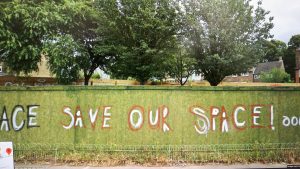
In this regularly updated page, you can find out about the detail of the work we are doing on individual cases.
- 8 April 2022. Good news! The High Court ruled in favour of campaigners led by the London Parks and Gardens Trust, in relation to Victoria Tower Gardens. Congratulations to the many campaigners involved!
- 6 April 2022 The link between professional and semi professional football clubs and threats to four London parks and green spaces Professional football or recreation and nature?
- 21 March 2022. 50 threats to London’s parks and green spaces – our March 2022 report Forever Green?
- 14 October 2022. The Park Road Allotments which we wrote about earlier this year have now been saved.
- We also have written in the past year about several other sites: Castle Green, Barking Rugby Club site (Nov 20); Wimbledon and Whitewebbs Parks (Oct 21); several green spaces in housing estates under threat from ‘infill‘ development (Oct 21); large areas of Enfield’s Green Belt including historic Enfield Chase (July 21); and sites in Bromley and Southwark (Mar 21) where we also highlighted the allotments threat which has happily now been thwarted.
Threats are often ongoing and can be very different. Here are some examples of threats we’re working on at the moment
#1 – 125 hectares of protected greenspace – Hounslow
By far and away the worst case on our books, Hounslow Council is set to destroy protected Green Belt the size of 200 football pitches. But plans to build over 125 hectares of Green Belt are unnecessary and unjustified. We do not need to build on our Green Belt. We have so much derelict and poorly-used space in London which can be redeveloped. The council is ignoring the potential for nearby, previously-developed sites, which currently make poor use of space, to be redeveloped instead.
London is incredibly lucky to have Green Belt: it protects valuable countryside needed for sports and recreation and top grade agricultural land, vital for our food security. It is our ‘climate safety belt’ – keeping our temperature under control and managing increasing flood and heavy rainfall events. It provides vital habitat for nature at a time which we are facing a nature crisis: many of the sites proposed for development are also Sites of Importance for Nature Conservation, known as SINCs. Green Belt also saves us from high-carbon sprawling development and makes sure we have a compact, low-carbon city. Sprawl will mean even more appalling traffic and pollution in an area already beset by major air quality and congestion issues.
And almost unbelievably, one of the sites proposed for development is the location of a ‘causewayed enclosure’ – a scheduled monument dating from between c.3000-2400 BC. Look closely at the aerial Google Satellite photo and you can still see the outline.
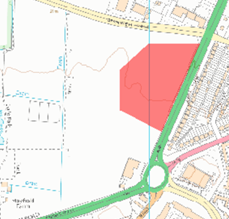
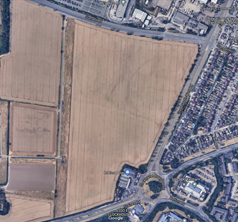
The London Borough of Hounslow is proposing de-designating Green Belt via its West of Borough Local Plan Review. Their proposals contravene Government and London Mayoral policy. CPRE London’s response is here. You can follow local campaigners Friends of The River Crane
#2 Victoria Tower Gardens – Westminster
Victoria Tower Gardens is a much loved, Grade II listed, recreation park used by individuals, groups of adults and school children. The Save Victoria Tower Gardens Campaign has been fighting against the construction of a Holocaust Memorial and Learning Centre in the Gardens, on the basis that believes that this park is the wrong site for ANY building. One of London’s historic Royal Parks, this is one of the only big, open, green spaces near to residents, office workers and tourists in and extremely busy part of London and it is a much loved and extremely well-used park.
It’s loss would be greatly felt.
Apart from the central fact that the amenity and history of the park will be lost, the arrival of the major new Holocaust Memorial will change the only remaining part of the park beyond recognition and stretch a part of London which is already struggling to cope with the huge number of visitors it receives. Ironically, there are a number of other sites which many people feel would be more appropriate for the memorial, for instance Hyde Park which hosts the existing Holocaust Memorial, the Imperial War Museum which currently hosts the permanent Holocaust Exhibition, or the Russell Square area which has historic links to London’s Jewish community.
Many organisations are supporting the campaign to Save Victoria Tower Gardens including ourselves and the London Gardens Trust where you can find updates on the latest situation.
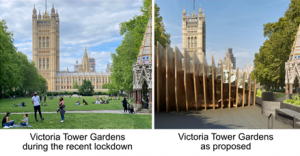
#3 Green Dale Park – Southwark
The Local football club was thrown out of its stadium by developers who bought the site, only to be invited to come back to a brand-new stadium which would be built on a neighbouring park. Now which football fan wouldn’t say yes to that? But it’s at the expense of destroying a local park and, ironically, a community football pitch which is one of the few free, turn-up-and-play facilities where local kids and adults can hone their skills.
The development will mean the site which is protected ‘Metropolitan Open Land’ will no longer be open but have a large stadium in the middle of it. And while ‘community access’ is promised, it will be charged and need to be booked: very different from the previous facility.
But most of all – this is an important local park. The first picture below shows the community football pitch (light green) which will be enclosed with high seating stands. It also shows the site of the old stadium to the right, which will also be lost to housing development. The second picture shows the space being enjoyed by local residents during the 2020 lockdown.
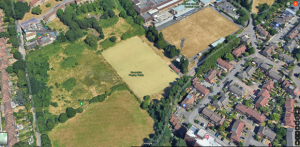
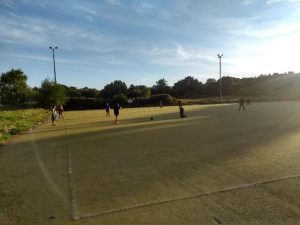
The site is protected Metropolitan Open Land (MOL) – which has the same level of protection as Green Belt – and for good reason – to make sure Londoners have access to quality green space in perpetuity. We are selling future generations short. The stadium should remain where it is and the park should be left alone. The reality is this is all about money. This park should not be sacrificed.
Sadly the London Mayor let the decision stand and did not over-ride the council’s decision that ‘special circumstances’ existed to justify undoing the ‘strongest protection’ which, as set out in planning guidance, is afforded to MOL. The Mayor has indicated that he strongly supports Green Belt and MOL protections in London but we are extremely concerned that the ‘special circumstances’ loophole is allowing pressure to be applied. We strongly believe this development does not meet the ‘Very Special Circumstances’ test for development on protected land and urge the Mayor to apply the test properly. Find out more here.
There should be a strict application of the ‘special circumstances’ test by the GLA in relation to all speculative Green Belt and MOL planning applications, not least because developers see weakness as a reason to purchase yet more protected land on a speculative basis.
#4 Duncombe Hill green space – Lewisham
Some sites are small but much loved by local communities. The green space at Duncombe Hill in Lewisham is one of these. A small pocket of green along a busy main road, it is the only pocket of green along a two mile stretch of main road, which has been accessible to, and used by, the public for many years. It is home to a willow tree, a sycamore tree, a Norway maple tree and 3 x crab apple trees. A small pocket of green along a busy main road, it is the only pocket of green along a two mile stretch of main road, which has been accessible to, and used by, the public for many years. It is home to a willow tree, a sycamore tree, a Norway maple tree and 3 x crab apple trees. It’s a key open space, and on the Brockley Three Peaks trail route.
The local community was unaware that the space was not owned by the council until developers bought it on a speculative basis and enclosed it with ugly hoardings. The council required the hoardings to be removed and placed preservation orders on the trees.
The developer has put in an appeal after their application was refused. It remains a threatened site for now. We are seeking an update on the current position on this case (as of Nov 2021).

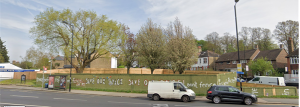
#5 Limehouse Triangle – Tower Hamlets
This is another small site in a very densely populated part of Tower Hamlets with very little green space nearby and it was a home to nature. In the lead up to 2000, the council was focusing on the environment and biodiversity and the Triangle was included as part of plans to improve the local area and borough. This included setting up recycling and litter picking initiatives. Recognising the importance of this project Tower Hamlets Council allocated money to finance it, the Met Police also provided funds so that all could work towards the Triangle’s green corridor status.
Many bulbs were planted and paid for by the London Borough of Tower Hamlets Council as part of this, including snowdrops, Aconites, bluebells, Daffodils/Narcossos wild, Summer snowflakes and Anemone. The Friends of Tower Hamlets Cemetery Park helped the council with planting ideas and 50m of native hedge including among others Hawthorn, Blackthorn, Crack Willow, Dog Rose, Dog Wood, Field Maple and Hazel was planted. A wild flower meadow mix was also planted including larkspur, Poppy (field), Forget-me-Knots, Cowslip, Callendula, Buttercup, Primroses, Daisies, Red Clover and Ragged Robin to name a few.
But since 2016 residents have had to repeatedly fight applications by the council to build on this land and on 1 April 2019 the Development Committee decided 17 properties in a block ranging from 5 to 8 storeys high should be built here.
It was local residents little piece of green space and a haven for wildlife.
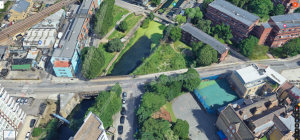
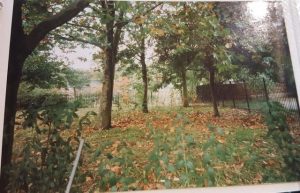
We are calling on London Boroughs and the Mayor to:
1. Walk the walk.
We can’t just talk about how important green space is: boroughs must simply stop permitting development on green space.
2. Ensure the ‘strongest protection’ means just that.
For protected land in particular (Green Belt and Metropolitan Open Land – which are subject to the ‘strongest protection’ in planning policy), far too often we see boroughs accepting a developer’s argument that there are “Very Special Circumstances”, a technical term for a justification, to build on protected land.
Technically developers are allowed to make a case, but it should be nigh on impossible to pass that test given that protected land is meant to be defined by its ‘permanence’. In reality the ‘justification’ mostly boils down to money. In the vast majority of cases there are suitable alternative sites for the development but it is too costly to buy and develop that site.
There should be strict application of the ‘Very Special Circumstances’ test by boroughs and the GLA in relation to all speculative Green Belt and MOL development proposals and if the bottom line is that it is simply about costs, then this cannot and should not be regarded as ‘Very Special Circumstances’.
Another justification frequently used is in relation to schools and the ‘pressure for school places’. We have consistently argued that this is a generalised pressure across London along with the need for new housing and other infrastructure. These are not, and should not be regarded as, ‘special’ circumstances. (If they were, the protection would be meaningless.) Ironically, having fought a number of cases in recent years where the ‘school place need’ justification was put forward, we now find that across London school rolls are falling and schools are not full.
We have also worked to demonstrate that there is a huge amount of under-used and previously-developed land in London, enough to build the housing and infrastructure we need for at least 20 years. Find out more.
Picture credits
Historic England image of Causewayed Enclosure in Hounslow https://historicengland.org.uk/listing/the-list/list-entry/1002043
Satellite image of Causewayed Enclosure in Hounslow – Google Maps
Victoria Tower Gardens – https://www.savevictoriatowergardens.co.uk/
Duncombe Hill – First image https://www.foresthillsociety.com/2019/04/planning-application-ducombe-hill-green.html second image Google Maps Streetview
Limehouse Triangle – Google Maps and local campaigners




